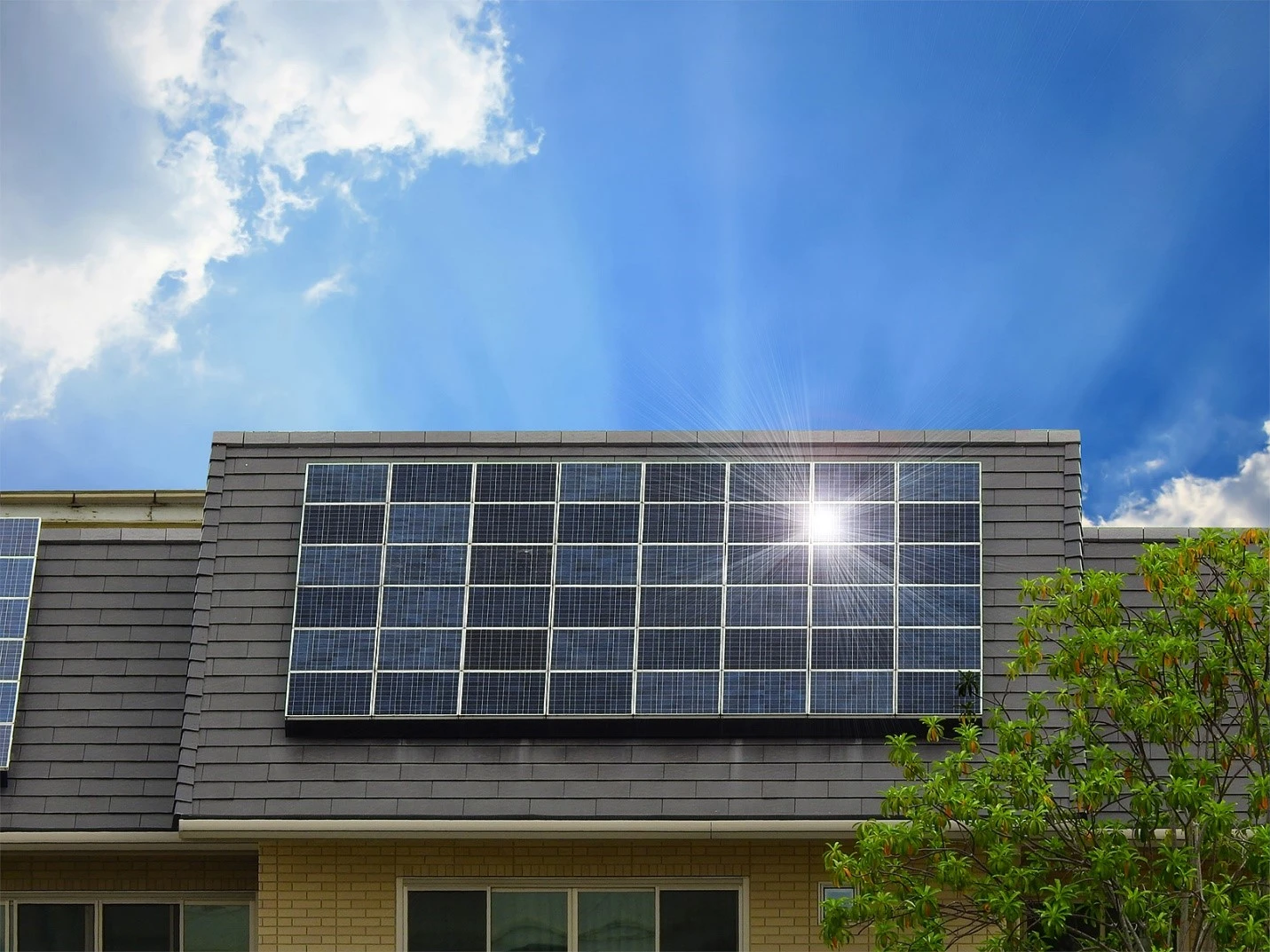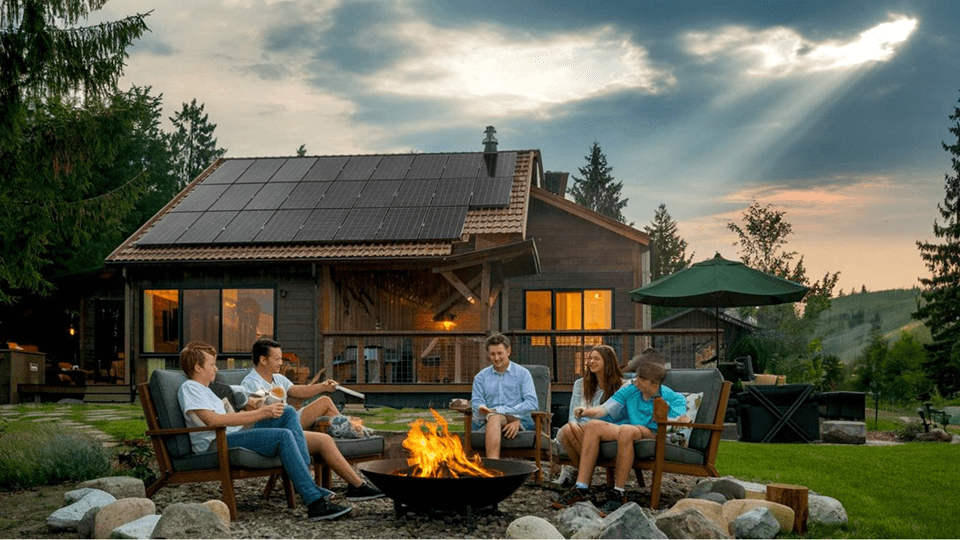- Updated On: June 14, 2025
Top Solar PV Losses: Impacts on System’s Efficiency and Tips to Control
Homeowners and businesses are investing in solar energy systems to reduce their energy costs, grid independence, and maximize their savings. However, you can only achieve these goals if your solar energy system is efficiently converting sunlight into power. Solar PV loss, like shading, dirt, temperature effects, electrical issues, etc., may impact the performance and output of your system. From module mismatch and soiling to temperature fluctuations and energy conversion inefficiencies, each component in the system can potentially lead to a loss of solar output. Identifying the causes of these PV losses is essential for optimizing the system’s design and increasing the efficiency of your solar panels.
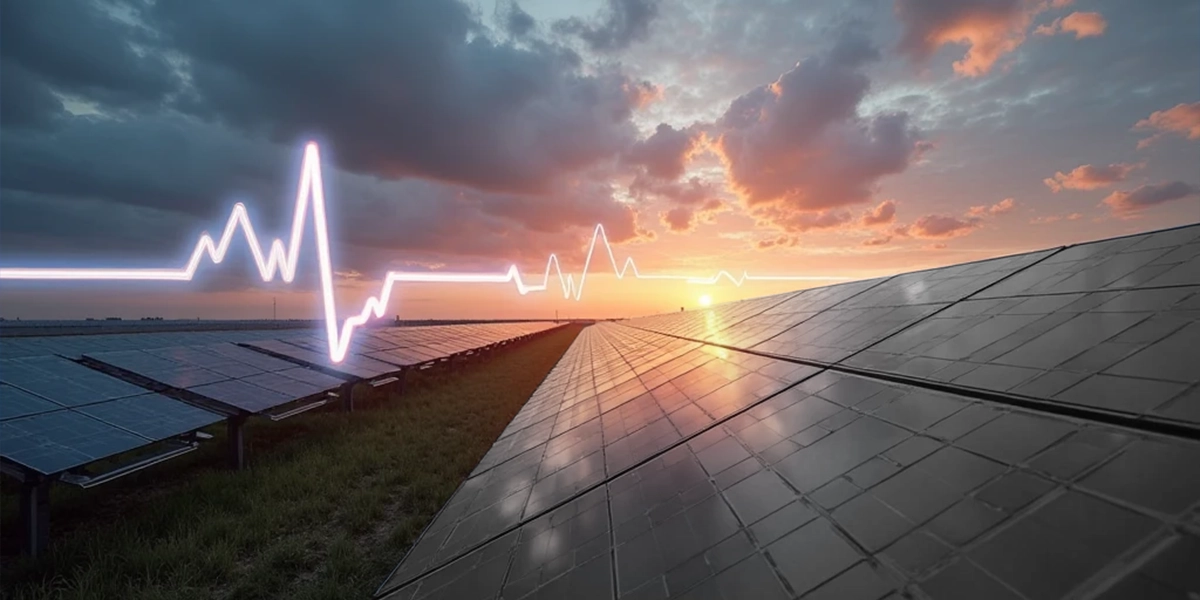
In this article, we will highlight the top solar PV losses, their causes, and their impact on your system performance. Also, we will share some practical tips to minimize these issues and enhance your energy production.
What is a solar PV loss?
PV system losses are the variance between the expected maximum output energy of a solar energy system and the actual energy it provides. A solar PV system loss occurs at various phases of energy conversion and transfer, from the solar radiation hitting the panels to providing usable electricity to your home or the grid. Even in ideal sunlight, there is not a 100% efficient solar power system due to environmental, electrical, and mechanical factors.
What are the different types of solar panel system losses?
We can divide the losses of a PV solar into three main categories:
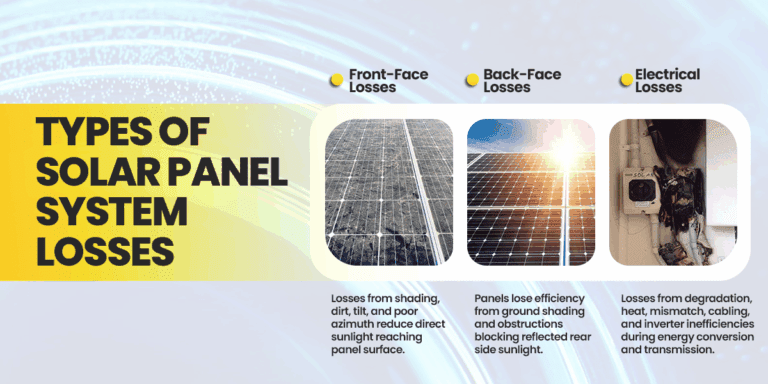
Front-face and back-face losses reflect the issues related to the ability of panels to capture sunlight. However, the electrical losses depict the power conversion problems.
What are the top solar energy system losses, and how do you prevent them?
Some of the common energy losses include:
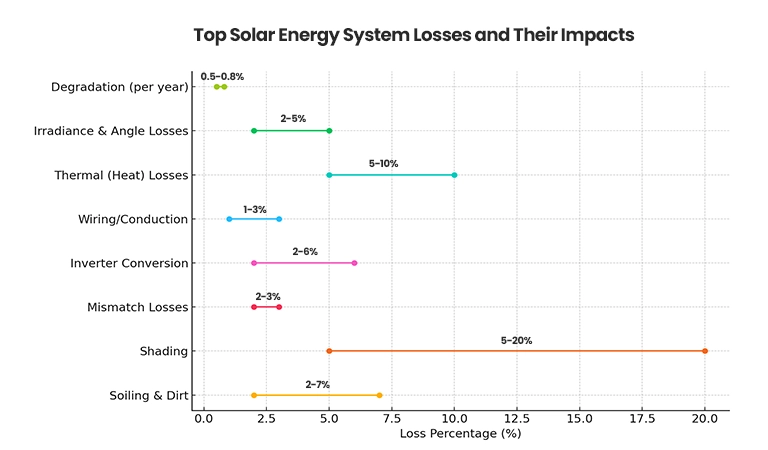
Shading Effects on Solar Panel System
Shading impacts directly on solar energy panels’ performance. The shade will decrease the efficiency of the PV system because this interrupts sunlight from directly hitting the panels. This issue can be more severe sometimes depending upon the shading condition. If half of the energy panels are under shade, it will then affect the production and the system will have a loss issue. But, on the other hand, a good solar design can decrease the degradation rate. Routine maintenance practice is also the solution to avoid this issue. Another type of shading is “soft shading.” This type refers to the shadow made by the clouds. In some geographical locations, where there are mostly clouds, this issue may occur. Soft shading generates diffuse light. But this is not as serious an issue as the hard shading.
Solutions:
- Nowadays, bypass diodes are fitted with energy systems. This helps the current to flow around those solar cells that may not work due to under-shading. This is the cheapest solution to deal with the solar shading losses. But also, the diodes are not a lifelong solution because of failure issues.
- Solar inverters are installed with a home solar power system to convert DC power into AC. Now if one solar panel is under shading, due to the series connection, the output will not reduce as much as in the case of shading it can. Also, a micro-inverter that converts to AC and sends the energy to a central box for further distribution can be installed on each panel as a This prevents the output of one solar panel from affecting the performance of the others.
Dust Effects on Solar Performance
Dust particles also impact the performance of the solar photovoltaic system. While making a solar design and calculations, energy experts should consider this energy system loss also. The dust factor depends upon the geographical location of your home. Like, if the home location is in a dusty weather area, this PV system loss cannot be ignored.
Solution:
The solution to deal with the dust factor is regular solar panel cleaning. The solar professionals recommend cleaning solar panel arrays once every six months. However, if you reside in dusty environments, you should clean your solar panels twice a month. This not only increases energy output by 3 to 5% on average but also improves efficiency by up to 25% in really dusty places.
Solar Array Optical Losses
Light photons interact with the P-N junctions in the solar cell’s crystalline structure to produce energy. Optical losses occur when light bounces off the panel’s surface rather than being absorbed into it to interact with the electrons. This is a feature of the panel design, and it is the focus of continuing research for increasing panel effectiveness. The difficult part is increasing light absorption while minimizing surface reflectance.
Solution:
This type of solar energy system loss can be overcome by adding another type of light-trapping mechanism or “roughing up” the surface with paint additives.
Solar Energy System Loss Due to Irradiance Level
System loss due to irradiance level shows the reduction in solar efficiency when the irradiance level decreases from the STC rating (standard test conditions) of 1000 W/m² to a low irradiance of 200 W/m².
Solution:
To minimize irradiance-related losses, optimize panel orientation and tilt for maximum sunlight exposure, use high-efficiency modules with good low-light performance, and include Maximum Power Point Tracking (MPPT) inverters.
Thermal Losses
A solar cell loses 0.5 percent of its output for every 1 degree C above the STC-rated temperature of 25 degrees C. That is why this is the most important loss in the energy system. This loss is due to an intrinsic feature of the solar cell structure.
Solution:
There are some innovative suggestions for minimizing thermal loss, like creating natural airflow channels by drilling holes or wide slits through the aluminum framework. Among other recommendations, one of the solutions is the use of a hybrid PV-thermal panel. This cools the face of the solar cells with water and recovers the heat for use in the building.
PV Modules Mismatch Loss
When two or more solar panels in an array produce differing amounts of energy, there is a mismatch. Two factors may contribute to this. One is the partial shade. Another is variations in the electrical properties of the solar cells.
Solution:
Using panels with integrated micro-inverters or adding panel-level electronics like DC optimizers is the best solution to mitigate mismatch loss.
DC Wiring Losses
It is not possible to eliminate DC cable losses because whenever current flows, it will lose energy. The objective is to minimize the loss as much as possible. Moreover, when current flows through the cables, their electrical resistance causes a voltage drop as well as power loss in the form of heating, which affects connections.
Solution:
The two basic strategies for reducing DC cable loss are proper wiring design and routine electrical maintenance.
AC Cable Losses
According to NEC solar code 2023, voltage drops are allowed up to 3% in AC or DC lines.
Solution:
The only way to reduce AC losses is by selecting the appropriate parts and building cable runs with the optimum cross-section area and a minimum length.
In conclusion, optimizing a solar PV system’s efficiency involves more than simply installing the best solar panels. Identifying and actively addressing a loss in a solar PV system through system design and monitoring activity may ensure maximum solar output and high ROI over the lifespan of your home solar energy system.
Related Articles:
Solar power is not just the cleanest; it’s the most abundant energy source on our planet. It’s estimated that the entire United States could be powered with about 22,000 square miles of solar panels.
Solar energy is an eco-friendly substitute for fossil fuels, which release greenhouse gasses that cause climate change. Solar energy is growing in popularity.
Ever wonder why people choose solar energy for their homes and businesses? Of course, the financial benefits of solar come first. The environmental benefits are the second most popular reason.

